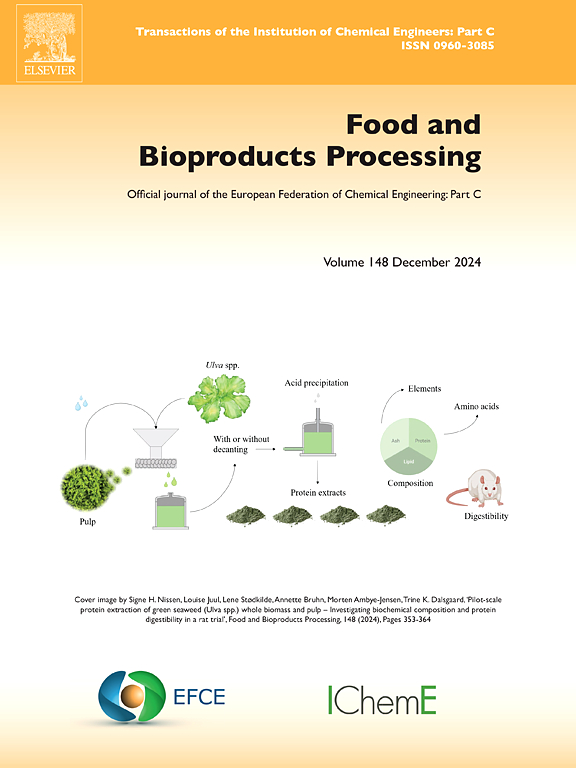Addressing the knowledge gap on pharmacologically relevant properties of structurally similar nitrofuran class drugs
IF 3.4
2区 农林科学
Q2 BIOTECHNOLOGY & APPLIED MICROBIOLOGY
引用次数: 0
Abstract
New data on the solubility (buffers pH 2.0, pH 5.0, pH 7.4, EtOH (ethanol), OctOH (1-octanol) and IPM (isopropyl myristate)), distribution (OctOH/buffer and IPM/buffer systems), and permeability through the polydimethylsiloxane-polycarbonate membrane (PDS) and PermeaPad barrier (PP) of three structurally similar nitrofuran class drugs: nifurtimox (NFM), nifuratel (NFT) and nifuroxazide (NFX) have been obtained. All the compounds appeared to be very sparingly soluble in the range of physiological pH. In addition, low solubility in organic solvents: EtOH > OctOH > IPM was also determined. The solubility of the studied substances in the organic solvents was shown to be higher than in the aqueous media. The values of the distribution coefficients appeared to be in agreement with the solubility in the respective solvents. According to the distribution in the OctOH/buffer system, only NFX matched the range of optimal lipophilicity (logD=1÷3) for successful absorption. Permeability of all the studied nitrofuran derivatives was shown to be essentially greater through the PP barrier as compared to the PDS membrane. The trends between the distribution coefficients and permeability were disclosed.
解决结构相似的硝基呋喃类药物的药理学相关性质的知识差距
获得了三种结构相似的硝基呋喃类药物:硝呋替莫(NFM)、硝呋替特(NFT)和硝呋噻嗪(NFX)的溶解度(缓冲液pH 2.0、pH 5.0、pH 7.4、EtOH(乙醇)、OctOH(1-辛醇)和IPM(豆豆酸异丙酯))、分布(OctOH/缓冲液和IPM/缓冲体系)和通过聚二甲基硅氧烷-聚碳酸酯膜(PDS)和PermeaPad屏障(PP)的渗透性(PP)的新数据。所有化合物在生理ph范围内都表现出极少量的可溶性。此外,在有机溶剂中的溶解度也很低:EtOH >; OctOH >; IPM也被测定。所研究的物质在有机溶剂中的溶解度高于在水介质中的溶解度。分布系数的值似乎与在各自溶剂中的溶解度一致。根据在OctOH/缓冲体系中的分布,只有NFX符合最佳亲脂性范围(logD=1÷3)才能成功吸收。与PDS膜相比,所有硝基呋喃衍生物通过PP屏障的渗透性都更大。揭示了分布系数与渗透率之间的变化趋势。
本文章由计算机程序翻译,如有差异,请以英文原文为准。
求助全文
约1分钟内获得全文
求助全文
来源期刊

Food and Bioproducts Processing
工程技术-工程:化工
CiteScore
9.70
自引率
4.30%
发文量
115
审稿时长
24 days
期刊介绍:
Official Journal of the European Federation of Chemical Engineering:
Part C
FBP aims to be the principal international journal for publication of high quality, original papers in the branches of engineering and science dedicated to the safe processing of biological products. It is the only journal to exploit the synergy between biotechnology, bioprocessing and food engineering.
Papers showing how research results can be used in engineering design, and accounts of experimental or theoretical research work bringing new perspectives to established principles, highlighting unsolved problems or indicating directions for future research, are particularly welcome. Contributions that deal with new developments in equipment or processes and that can be given quantitative expression are encouraged. The journal is especially interested in papers that extend the boundaries of food and bioproducts processing.
The journal has a strong emphasis on the interface between engineering and food or bioproducts. Papers that are not likely to be published are those:
• Primarily concerned with food formulation
• That use experimental design techniques to obtain response surfaces but gain little insight from them
• That are empirical and ignore established mechanistic models, e.g., empirical drying curves
• That are primarily concerned about sensory evaluation and colour
• Concern the extraction, encapsulation and/or antioxidant activity of a specific biological material without providing insight that could be applied to a similar but different material,
• Containing only chemical analyses of biological materials.
 求助内容:
求助内容: 应助结果提醒方式:
应助结果提醒方式:


